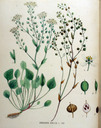
hæwen-hnydele
noun,
f.,
n-decl.,
8 occ.
Type: plant
Last Update: 26.06.2014 21:34
Old-English: hæwen hnydele, hæwen hydele, hæwenydele, heavenhnidele, henephydele,
Latin (Machine generated): BRITTANICA, BRITTANICE,
↑ topMeanings Last Update: 26.06.2014 21:34
-
C: plant: native
Cochlearia anglica L., scurvygrass, Englisches Löffelkraut -
D: plant: native
Succisa pratensis Moench, Devil's bit scabious, Gewöhnlicher Teufelsabbiss -
E: plant: native
Centaurea cyanus L., cornflower, Kornblume -
B: plant: native Several native species.
? Rumex L, dock species, Ampfer-Art -
A: plant: native Several native species.
??? Galeopsis L., hemp nettle, Hohlzahn -
F: plant: native
??? Primula veris L., cowslip, Echte Schlüsselblume -
G: plant: foreign Probably extinct in BI (cf. Clapham 1962,832)
??? Inula britannica L., British elecampane, Ufer-Alant
Comments Last Update: 23.11.2011 21:25
-
Comment on (A): ??? Galeopsis L., hemp nettle, Hohlzahn
-
Comment on (B): ? Rumex L, dock species, Ampfer-Art
According to André (s.v.) BRITANNICA denotes a Rumex species.[2] D'Aronco (1998,50) suggests Rumex aquaticus L., red dock, Wasserampfer; or Rumex hydrolapathum L., great water-dock, Flussampfer; also suggested by Petitt (2001,233).
-
Comment on (C): Cochlearia anglica L., scurvygrass, Englisches Löffelkraut
Identification based on L plant name, also suggested by Cockayne (1962,I,127) but see meaning A. According to Marzell (2000,1,1066f.) BRITANNICA is Cochlearia L., a plant which is used for its anti-scorbutic properties in HA[3] (indications which are mentioned as early as Pliny 25,212); cf. Biggam's study of this L plant name (1997,132-181).
-
Comment on (D): Succisa pratensis Moench, Devil's bit scabious, Gewöhnlicher Teufelsabbiss
Biggam bases her conclusions on a minute study of both text (medical traditions and indications) and illustrations of the historical manuscripts (1997,132-177).
-
Comment on (E): Centaurea cyanus L., cornflower, Kornblume
Based on ModE plant names Biggam (1997,167ff.) also suggests C. cyanus as possible identification although the medical indications do not match the historical tradition.
-
Comment on (F): ??? Primula veris L., cowslip, Echte Schlüsselblume
Hunt (1989, s.v. BRITANNICA) tentatively introduces this identification but his survey is based on later sources and may be a possible identification for a ME plant name but it is not applicable to the OE plant name cf. Biggam (1994,617) and s.v. →cū-slyppe.
-
Comment on (G): ??? Inula britannica L., British elecampane, Ufer-Alant
Suggested by Storms without further explanation (1948,323).
Occurrences Last Update: 04.08.2009 16:26
Etymology Last Update: 26.06.2014 21:34
- Etymology: Etymology-Comment:
- Word-Formation:
- Word-Formation-Comment:
Images Last Update: 26.06.2014 21:34
Cochlearia anglica L., scurvygrass, Englisches Löffelkraut |
|

|
Kops, Jan, and F. W. van Eeden.
Flora Batava of Afbeelding en Beschrijving van Nederlandsche Gevassen. XVI. Deel. Leiden: De Breuk en Smits, 1881.
|
Succisa pratensis Moench, Devil's bit scabious, Gewöhnlicher Teufelsabbiss |
|

|
Botanical-Information: stylised plate
Losch, Friedrich.
Kräuterbuch. München: 1914.
|
Centaurea cyanus L., cornflower, Kornblume |
|

|
Botanical-Information: stylised plate
Thomé, Otto Wilhelm.
Flora von Deutschland, Österreich und der Schweiz. In 4 Mappen ; 531 Tafeln in naturgetreuen Farben mit 668 Pflanzenarten. Leipzip: Teubner, 1938.
|
??? Primula veris L., cowslip, Echte Schlüsselblume |
|

|
Botanical-Information: stylised plate
Thomé, Otto Wilhelm.
Flora von Deutschland, Österreich und der Schweiz. In 4 Mappen ; 531 Tafeln in naturgetreuen Farben mit 668 Pflanzenarten. Leipzip: Teubner, 1938.
|
??? Inula britannica L., British elecampane, Ufer-Alant |
|

|
Botanical-Information: stylised plate
Kops, Jan, and F. W. van Eeden.
Flora Batava of Afbeelding en Beschrijving van Nederlandsche Gevassen. XVI. Deel. Leiden: De Breuk en Smits, 1881.
|
Research Literature
Cf. Lindheim"s note on Dur 68: "In hnydele eine "Nesselart" sehen zu. wollen (Cock.II 389), ist bei der ungesicherten Etymologie von "Nessel" nicht gut möglich. Auch das Farbadjektiv hæwen bietet keinen Anhaltspunkt, da es die verschiedensten Farben (grau, grün, blau, purpurn) bezeichnen kann." We also have to note that in LA 98/19f hæwene hnydelan is printed as hæwene dile in a nearly identical recipe in Cockayne"s "Fly Leaf Leechdoms" (1951,I,374).
"plante originaire de Frise, esp. de Rumex aquatique antiscorbutique (cf. CGL 3,587,40a, HERBA QUAE NASCITUR IN CISTERNA)". Also cf. MED, s.v. hudela.
HA XXX: "Wiþ muþes sare".
N.: "-h- before -y- blotted out. -l- after -y- struck out by the first scribe."
MS H: hæwenen.
MS H: hæwenen.
Hilbelink: BRITTANICA ƀ is heawen hnydela; hæwen hnydele B; hæwen hydele H.
Grattan / Singer (1951,122,A14): "hæwen (or hæwenu): hæwene MS. CL, a very late corruption."
Grattan / Singer (1951,98,A.12): "First -n- above line, same hand."
 print
print
Cockayne (1962,II,329) suggested this identification which in Grattan / Singer (1951,88) became Lamium purpuraeum L., read dead-nettle, Rote Taubnessel. The identification is based on an assumed etymological connection to OE [LINKT netele]. But nettle seems to be related to Igmc. *ned- 'wind together, knot, zusammendrehen, knüpfen' and therefore has to be excluded.[1] Also cf. Biggam (1997,164f) on the etyology of hnydele.